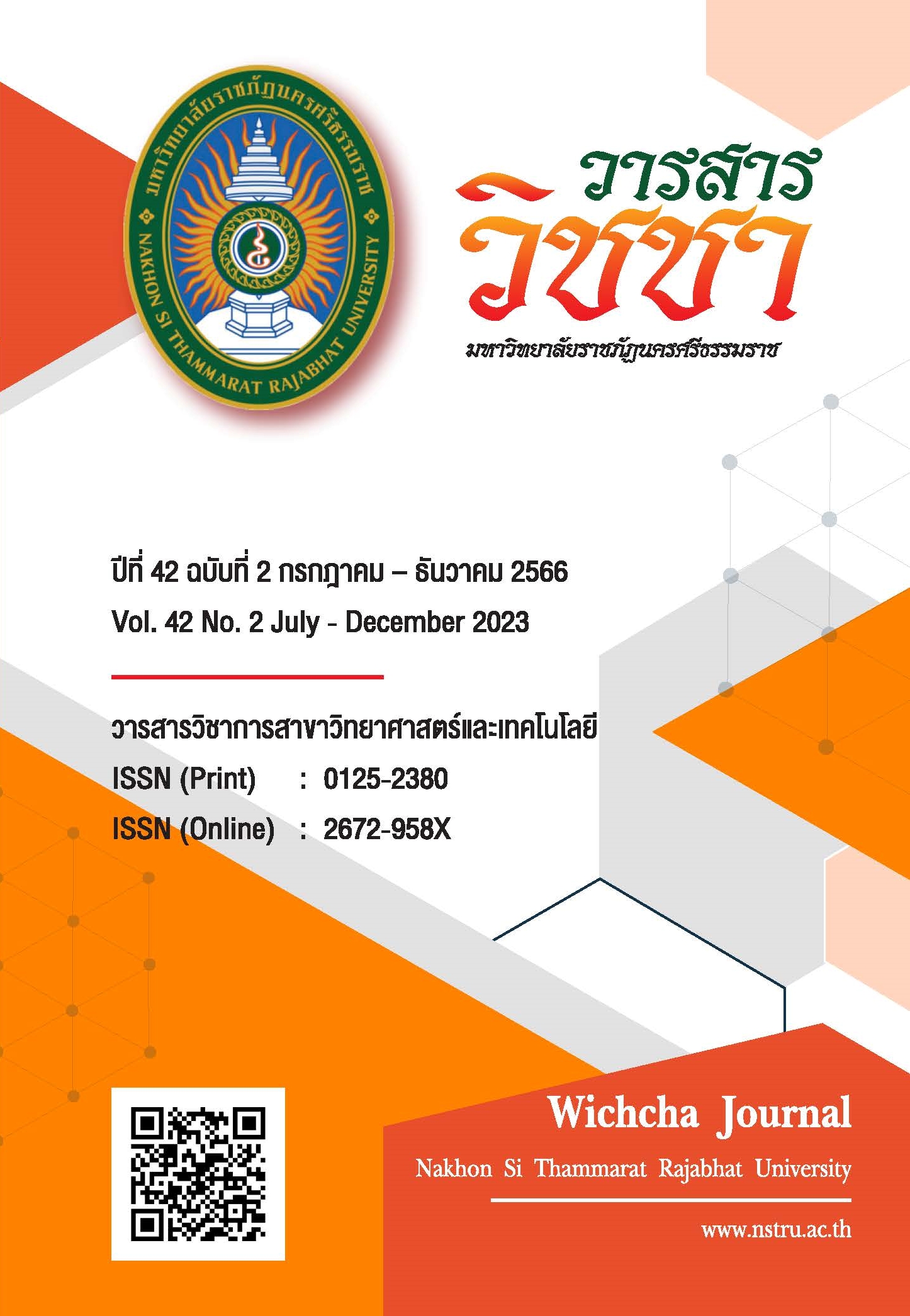Using the RD 43 Rice Flour to Replace Wheat Flour in Cookies
Main Article Content
Abstract
This research aimed to investigate the effect of wheat flour substitution with RD 43 rice on the characteristics and sensory properties of cookies. RD 43 rice flour was substituted in the cookie formula at the quantity levels of 0, 25, 30, 35 and 40% by weight of wheat flour. The results found that the increased content of RD 43 rice flour significantly increased lightness (L*) whereas yellowness (a*) and redness (b*) decreased. Additionally, the hardness significantly decreased according to substitution levels of rice flour (p < 0.05). The water activity (aw) of rice flour cookies substituted with RD 43 showed no significant differences (p ≥ 0.05) with the values in the range of 0.42-0.43 and moisture content of 2.37% in contrast to the controlled formula. The sensory evaluation form based on 9-point hedonic scales done by 30 untrained panelists found that the substitution of wheat flour by 30% of RD 43 rice flour in making cookies had higher preferred scores for color, odor, taste, texture, and had the higher overall preferred score at a strongly preferred level than the cookies samples that substituted with RD 43 rice flour at other ratios.
Article Details

This work is licensed under a Creative Commons Attribution-NonCommercial-NoDerivatives 4.0 International License.
เนื้อหาและข้อมูลในบทความที่ลงตีพิมพ์ในวารสารวิชชา มหาวิทยาลัยราชภัฏนครศรีธรรมราช ถือเป็นข้อคิดเห็นและความรับผิดชอบของผู้เขียนบทความโดยตรง ซึ่งกองบรรณาธิการวารสารไม่จำเป็นต้องเห็นด้วยหรือร่วมรับผิดชอบใด ๆ
บทความ ข้อมูล เนื้อหา รูปภาพ ฯลฯ ที่ได้รับการตีพิมพ์ในวารสารวิชชา มหาวิทยาลัยราชภัฏนครศรีธรรมราช ถือเป็นลิขสิทธ์ของวารสารวิชชา มหาวิทยาลัยราชภัฏนครศรีธรรมราช หากบุคคลหรือหน่วยงานใดต้องการนำข้อมูลทั้งหมดหรือส่วนหนึ่งส่วนใดไปเผยแพร่ต่อหรือเพื่อการกระทำการใด ๆ จะต้องได้รับอนุญาตเป็นลายลักษณ์อักษรจากวารสารวิชชา มหาวิทยาลัยราชภัฏนครศรีธรรมราชก่อนเท่านั้น
The content and information in the article published in Wichcha journal Nakhon Si Thammarat Rajabhat University, It is the opinion and responsibility of the author of the article. The editorial journals do not need to agree. Or share any responsibility.
References
กรมการข้าว. (2564). ข้าว กข. 43. สืบค้นเมื่อ 13 ธันวาคม 2564, จาก: https://www.thairicedb.com/productintro-detail.php.
กล้าณรงค์ ศรีรอด และเกื้อกูล ปิยะจอมขวัญ. (2550). เทคโนโลยีของแป้ง. (พิมพ์ครั้งที่ 4). กรุงเทพฯ: มหาวิทยาลัยเกษตรศาสตร์.
จารุวรรณ นามวัฒน์ และจันทร์เฉิดฉาย สังเกตกิจ. (2560). การทดแทนแป้งสาลีด้วยแป้งข้าวกล้องในเค้กกล้วยหอม. การประชุมวิชาการระดับชาตินวัตกรรมและเทคโนโลยีวิชาการ 2017 “วิจัยจากองค์ความรู้สู่การพัฒนาอย่างยั่งยืน”. สุรินทร์.
จิตธนา แจ่มเมฆ และอรอนงค์ นัยวิกุล. (2553). เบเกอรีเทคโนโลยีเบื้องต้น. (พิมพ์ครั้งที่ 10). มหาวิทยาลัยเกษตรศาสตร์.
ดุลจิรา สุขบุญญสถิตย์ บุษยา เรืองศักดิ์ วาทิตย์ ศรีทอง และโสภิดา เชื้อขุดทด. (2560). ผลของการใช้แป้งมันเทศทดแทนแป้งสาลีต่อคุณลักษณะของคุกกี้. แก่นเกษตร, 45(พิเศษ 1), 1060-1065.
นรินทร์ เจริญพันธ์. (2561). การผลิตเค้กลูกชุบจากแป้งปลายข้าวหอมมะลิไทย. วารสารวิทยาศาสตร์และเทคโนโลยี, 27(5), 915-923.
ประเวศ แสงเพชร. (2562). ข้าวพันธุ์ กข 43 เหตุใดจึงเหมาะกับผู้ป่วยโรคเบาหวาน. สืบค้นเมื่อ 12 ธันวาคม 2565, จาก: https://www.technologychaoban.com/bullet-newstoday/article_93009.
ยงยุทธ เสาวพฤกษ์. (2561). แนวโน้มอาหารและเครื่องดื่มเพื่อสุขภาพ. สืบค้นเมื่อ 6 พฤษภาคม 2566, จาก: https://www.prachachat.net/columns/news-268743.
วิภาวัน จุลยา. (2549). คุกกี้ & ช็อกโกแลต. (พิมพ์ครั้งที่ 3). กรุงเทพฯ: เพชรประกาย.
ศุภมาตร ปาลรังสี. (2554). การรับรู้โอกาสเสี่ยงและความรุนแรงของโรคเบาหวานชนิดที่ 2 โรคความดันโลหิตสูงและโรคหัวใจขาดเลือดสำหรับบุคคลวัยผู้ใหญ่วัยผู้สูงอายุจังหวัดนครศรีธรรมราช. วิชชา วารสารวิชาการมหาวิทยาลัยราชภัฏนครศรีธรรมราช, 30(1), 193-208.
สมหวัง เล็กจริง ปารมี หนูนิ่ม สุจินดา บุตตะจีน และปัทมา จันทวงศ์. (2562). ผลของการทดแทนแป้งข้าวสาลีด้วยแป้งข้าวกล้องสังข์หยดต่อคุณภาพทางเคมีกายภาพและประสาทสัมผัสในผลิตภัณฑ์ขนมขบเคี้ยว. แก่นเกษตร, 47(พิเศษ 1), 679-684.
อรอนงค์ นัยวิกุล. (2547). ข้าว: วิทยาศาสตร์และเทคโนโลยี. กรุงเทพฯ: มหาวิทยาลัยเกษตรศาสตร์.
อริสรา รอดมุ้ย และอรอุมา จิตรวโรภาส. (2550). การผลิตคุกกี้โดยใช้แป้งข้าวหอมนิลทดแทนแป้งสาลีบางส่วน. วารสารเทคโนโลยีการอาหาร มหาวิทยาลัยสยาม, 3(1), 37-43.
Helrich, K. (1995). Official methods of analysis of the association of official analytical chemists. (15th ed). Washington, DC: Association of Official Analytical Chemists.
Dhaka, V., and Khatkar, B.S. (2015). Effect of gliadin/glutenin and HMS-GS/LMW-GS ration on dough rhelogical properties and bread-making potential of wheat varieties. Journal of Food Quality, 38(2), 71-82, doi: https://doi.org/10.1111/jfq.12122.


